A Data Warehouse Engineering Power Point Presentation 2022
VerifiedAdded on 2022/10/18
|13
|731
|53
Presentation
AI Summary
Contribute Materials
Your contribution can guide someone’s learning journey. Share your
documents today.

A Data Warehouse
Engineering
Process
- Presented by
Hemanth Velamati(43918)
Arun Deepak Reddy
Naramreddy(43914)
Vivek Nacchu ( 44488)
Engineering
Process
- Presented by
Hemanth Velamati(43918)
Arun Deepak Reddy
Naramreddy(43914)
Vivek Nacchu ( 44488)
Secure Best Marks with AI Grader
Need help grading? Try our AI Grader for instant feedback on your assignments.
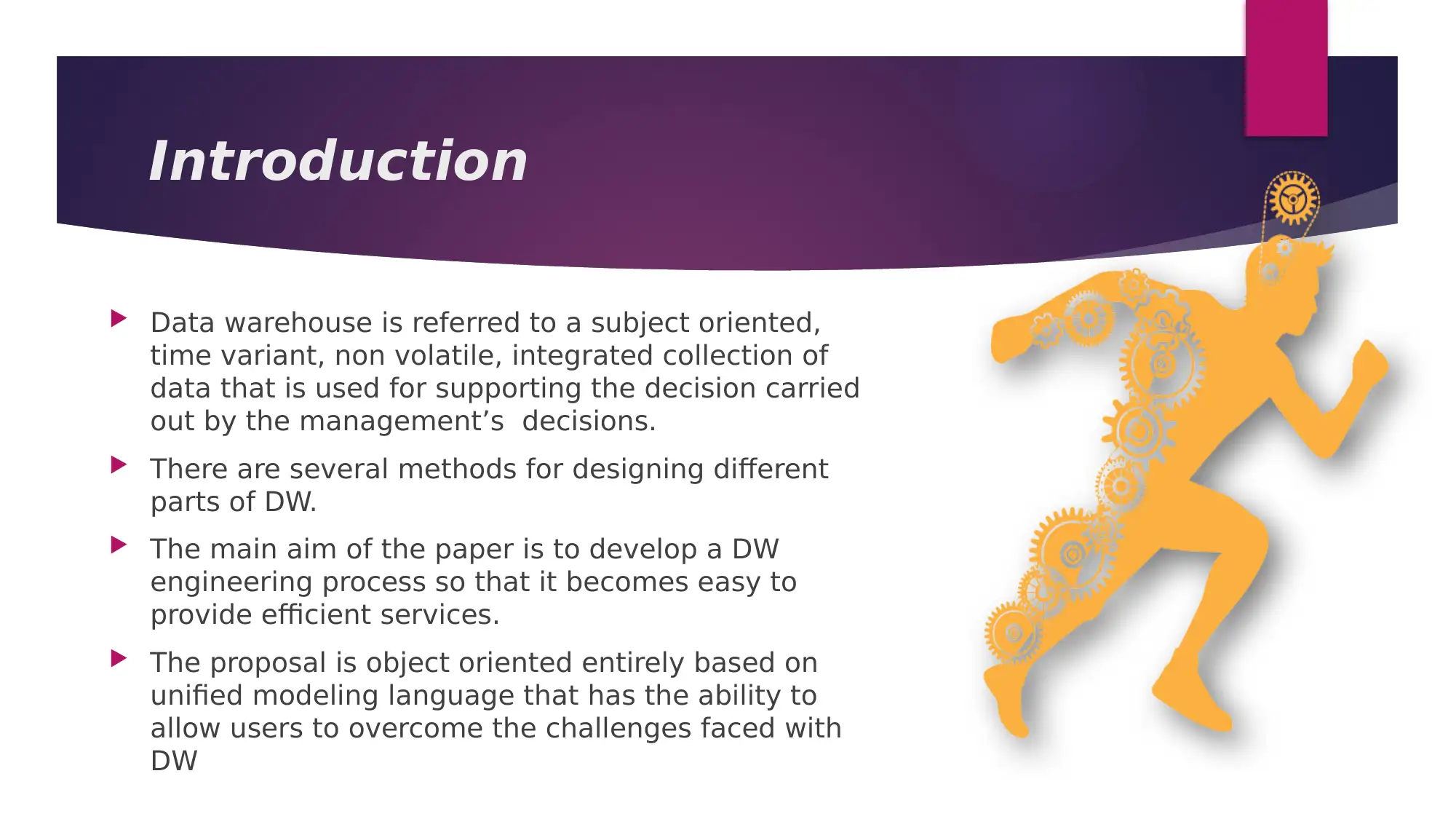
Introduction
Data warehouse is referred to a subject oriented,
time variant, non volatile, integrated collection of
data that is used for supporting the decision carried
out by the management’s decisions.
There are several methods for designing different
parts of DW.
The main aim of the paper is to develop a DW
engineering process so that it becomes easy to
provide efficient services.
The proposal is object oriented entirely based on
unified modeling language that has the ability to
allow users to overcome the challenges faced with
DW
Data warehouse is referred to a subject oriented,
time variant, non volatile, integrated collection of
data that is used for supporting the decision carried
out by the management’s decisions.
There are several methods for designing different
parts of DW.
The main aim of the paper is to develop a DW
engineering process so that it becomes easy to
provide efficient services.
The proposal is object oriented entirely based on
unified modeling language that has the ability to
allow users to overcome the challenges faced with
DW
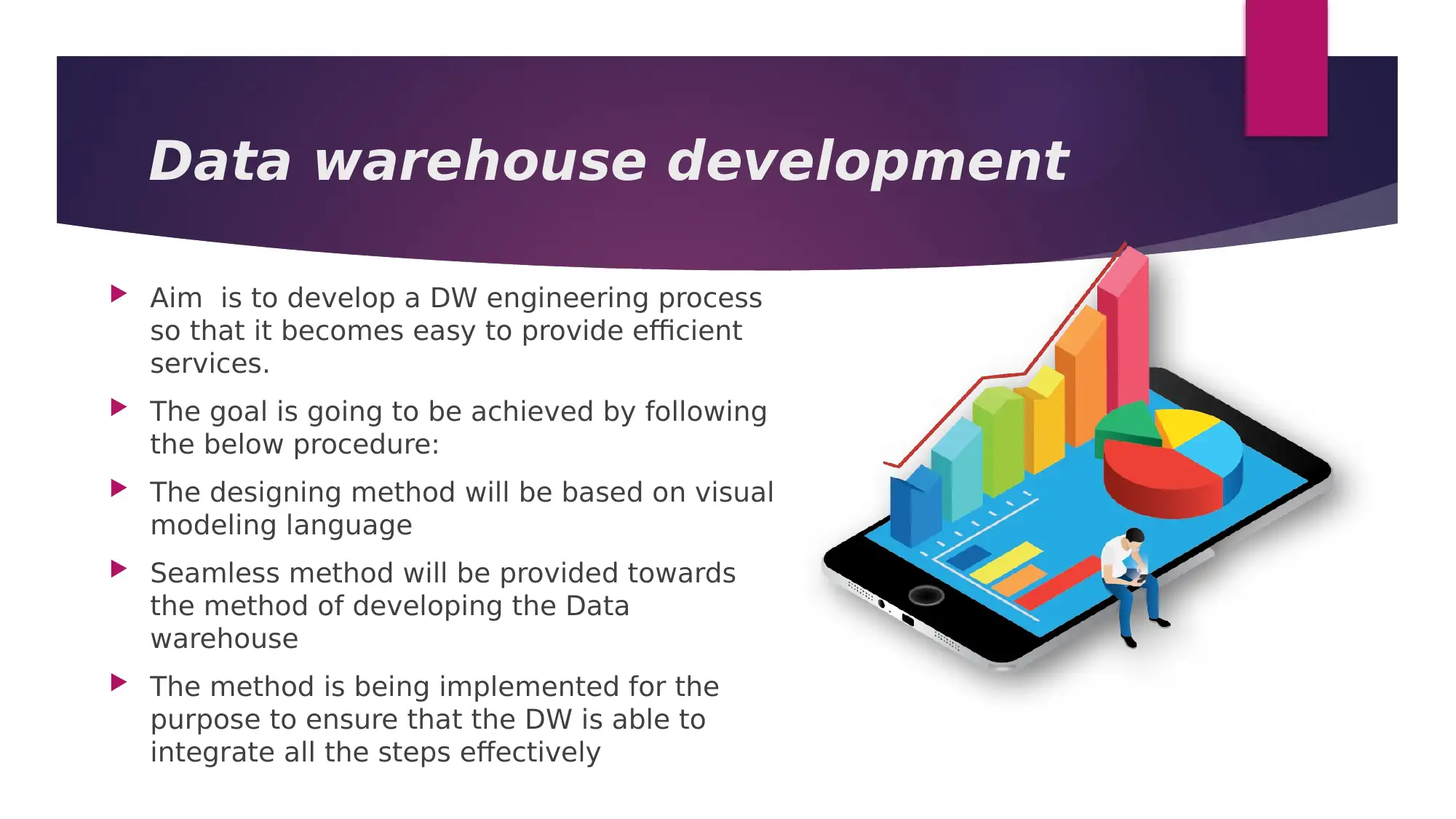
Data warehouse development
Aim is to develop a DW engineering process
so that it becomes easy to provide efficient
services.
The goal is going to be achieved by following
the below procedure:
The designing method will be based on visual
modeling language
Seamless method will be provided towards
the method of developing the Data
warehouse
The method is being implemented for the
purpose to ensure that the DW is able to
integrate all the steps effectively
Aim is to develop a DW engineering process
so that it becomes easy to provide efficient
services.
The goal is going to be achieved by following
the below procedure:
The designing method will be based on visual
modeling language
Seamless method will be provided towards
the method of developing the Data
warehouse
The method is being implemented for the
purpose to ensure that the DW is able to
integrate all the steps effectively
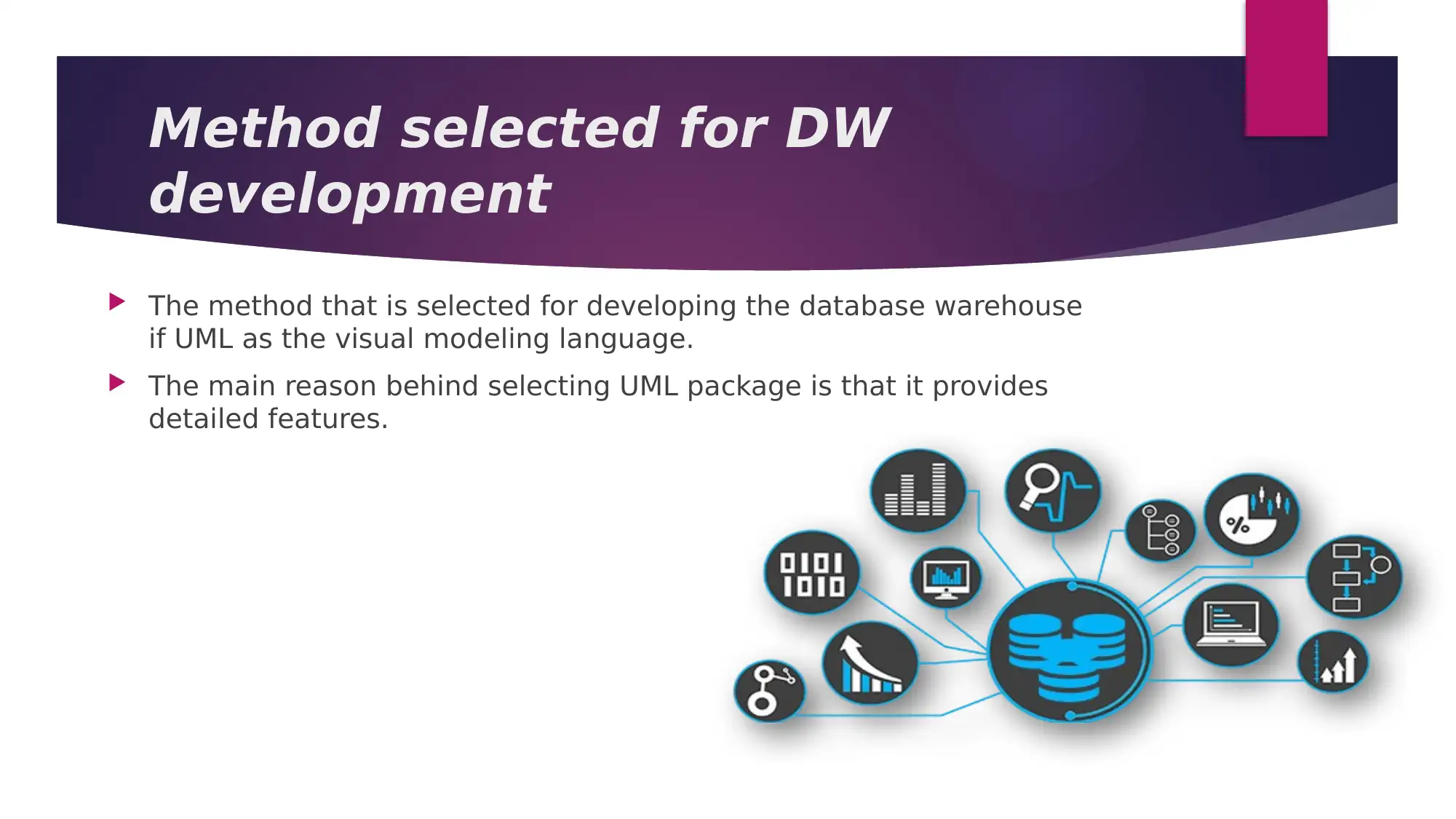
Method selected for DW
development
The method that is selected for developing the database warehouse
if UML as the visual modeling language.
The main reason behind selecting UML package is that it provides
detailed features.
development
The method that is selected for developing the database warehouse
if UML as the visual modeling language.
The main reason behind selecting UML package is that it provides
detailed features.
Secure Best Marks with AI Grader
Need help grading? Try our AI Grader for instant feedback on your assignments.
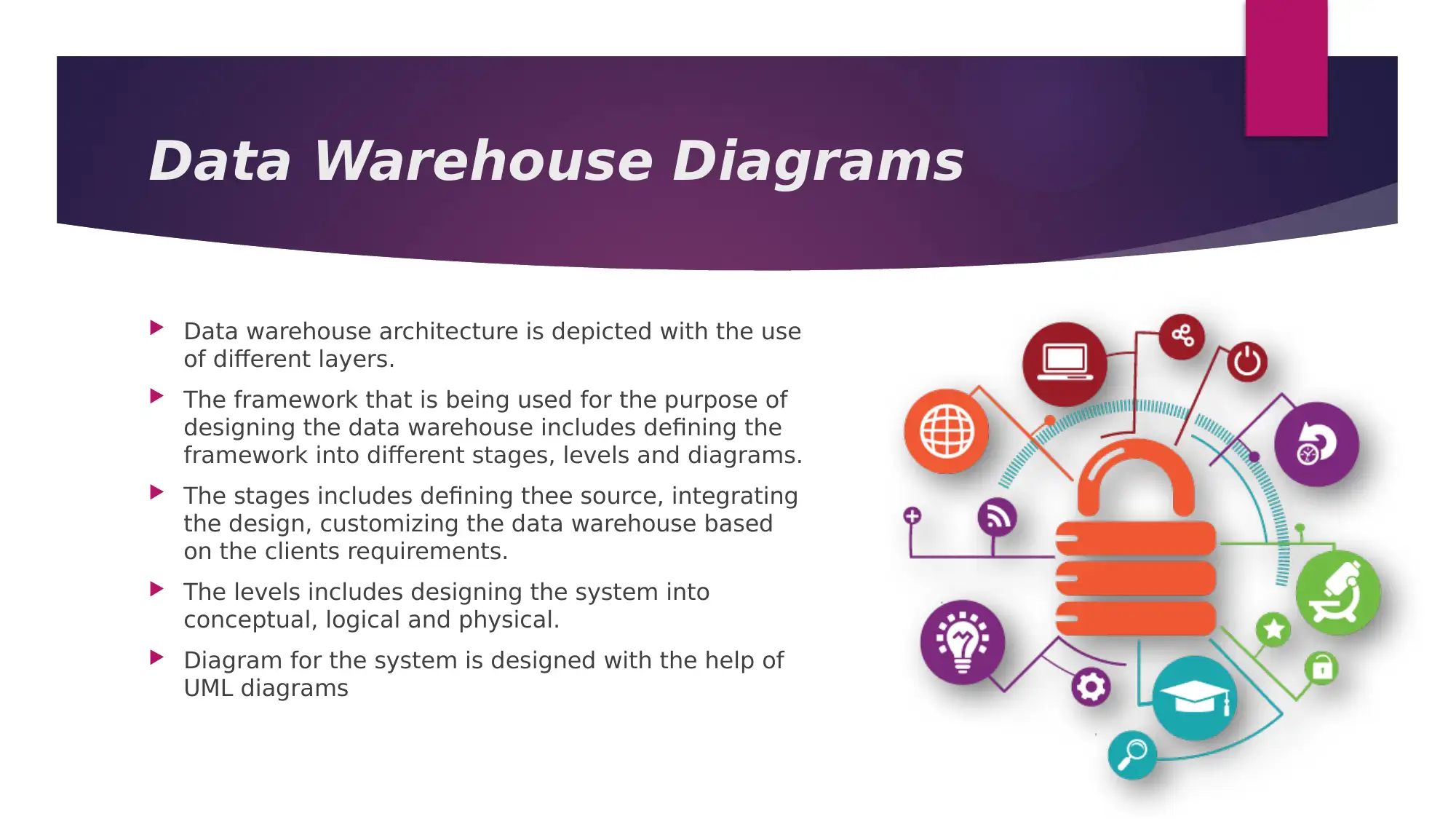
Data Warehouse Diagrams
Data warehouse architecture is depicted with the use
of different layers.
The framework that is being used for the purpose of
designing the data warehouse includes defining the
framework into different stages, levels and diagrams.
The stages includes defining thee source, integrating
the design, customizing the data warehouse based
on the clients requirements.
The levels includes designing the system into
conceptual, logical and physical.
Diagram for the system is designed with the help of
UML diagrams
Data warehouse architecture is depicted with the use
of different layers.
The framework that is being used for the purpose of
designing the data warehouse includes defining the
framework into different stages, levels and diagrams.
The stages includes defining thee source, integrating
the design, customizing the data warehouse based
on the clients requirements.
The levels includes designing the system into
conceptual, logical and physical.
Diagram for the system is designed with the help of
UML diagrams
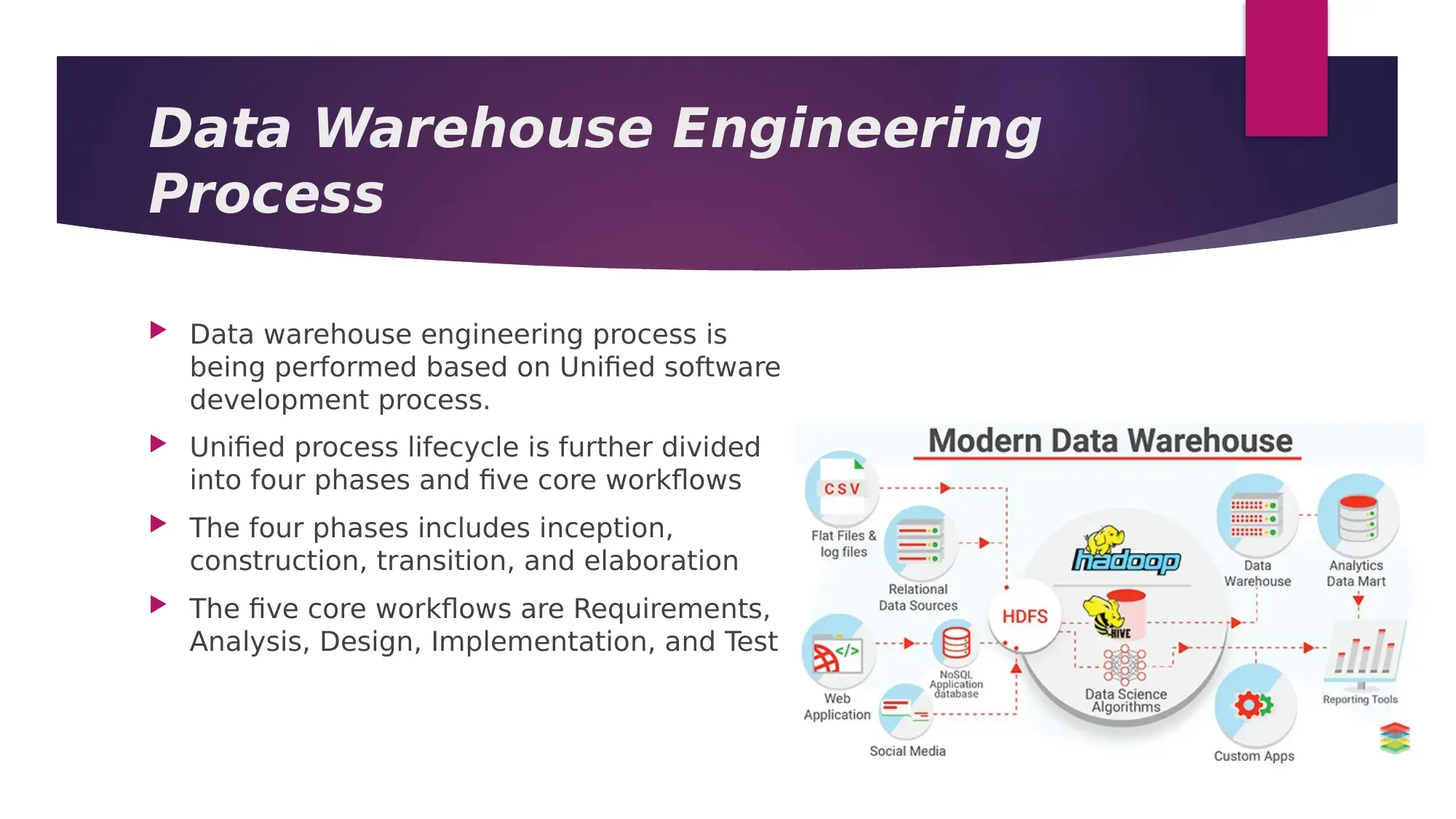
Data Warehouse Engineering
Process
Data warehouse engineering process is
being performed based on Unified software
development process.
Unified process lifecycle is further divided
into four phases and five core workflows
The four phases includes inception,
construction, transition, and elaboration
The five core workflows are Requirements,
Analysis, Design, Implementation, and Test
Process
Data warehouse engineering process is
being performed based on Unified software
development process.
Unified process lifecycle is further divided
into four phases and five core workflows
The four phases includes inception,
construction, transition, and elaboration
The five core workflows are Requirements,
Analysis, Design, Implementation, and Test
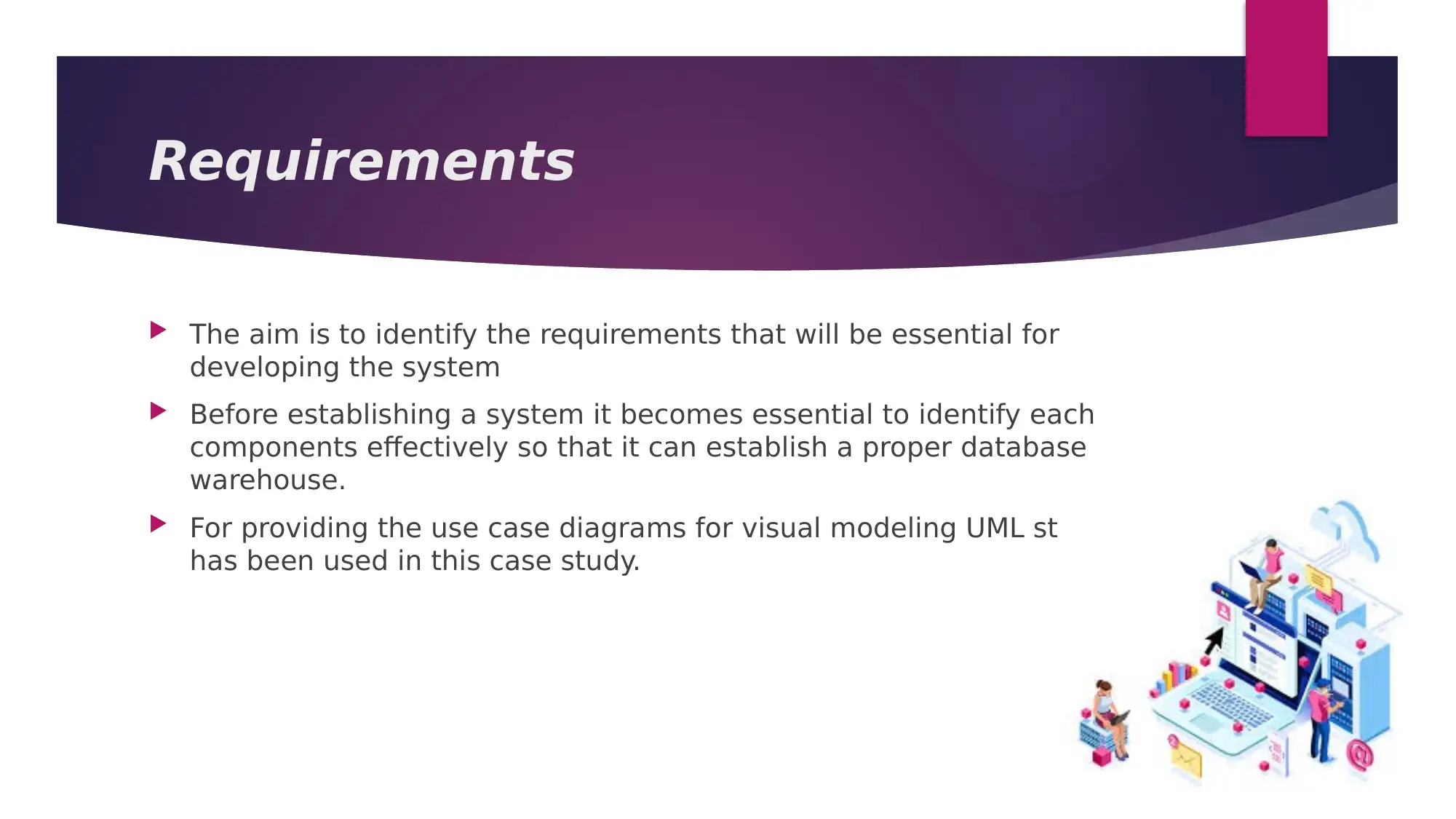
Requirements
The aim is to identify the requirements that will be essential for
developing the system
Before establishing a system it becomes essential to identify each
components effectively so that it can establish a proper database
warehouse.
For providing the use case diagrams for visual modeling UML standard
has been used in this case study.
The aim is to identify the requirements that will be essential for
developing the system
Before establishing a system it becomes essential to identify each
components effectively so that it can establish a proper database
warehouse.
For providing the use case diagrams for visual modeling UML standard
has been used in this case study.
Paraphrase This Document
Need a fresh take? Get an instant paraphrase of this document with our AI Paraphraser

Analysis and designing
The aim is to prepare a proper structure along with all
necessary requirements for the output.
Source Conceptual (Logical, Physical) Schema (SCS,
SLC, and SPS) is used for modeling the data structures
The main diagrams for the system are Data Warehouse
Conceptual Schema (DWCS), the Client Conceptual
Schema (CCS), and the Data Mapping (DM).
DM is used for representing the relationship between
the SCS and DWCS and DWCS and CCS.
The aim is to prepare a proper structure along with all
necessary requirements for the output.
Source Conceptual (Logical, Physical) Schema (SCS,
SLC, and SPS) is used for modeling the data structures
The main diagrams for the system are Data Warehouse
Conceptual Schema (DWCS), the Client Conceptual
Schema (CCS), and the Data Mapping (DM).
DM is used for representing the relationship between
the SCS and DWCS and DWCS and CCS.
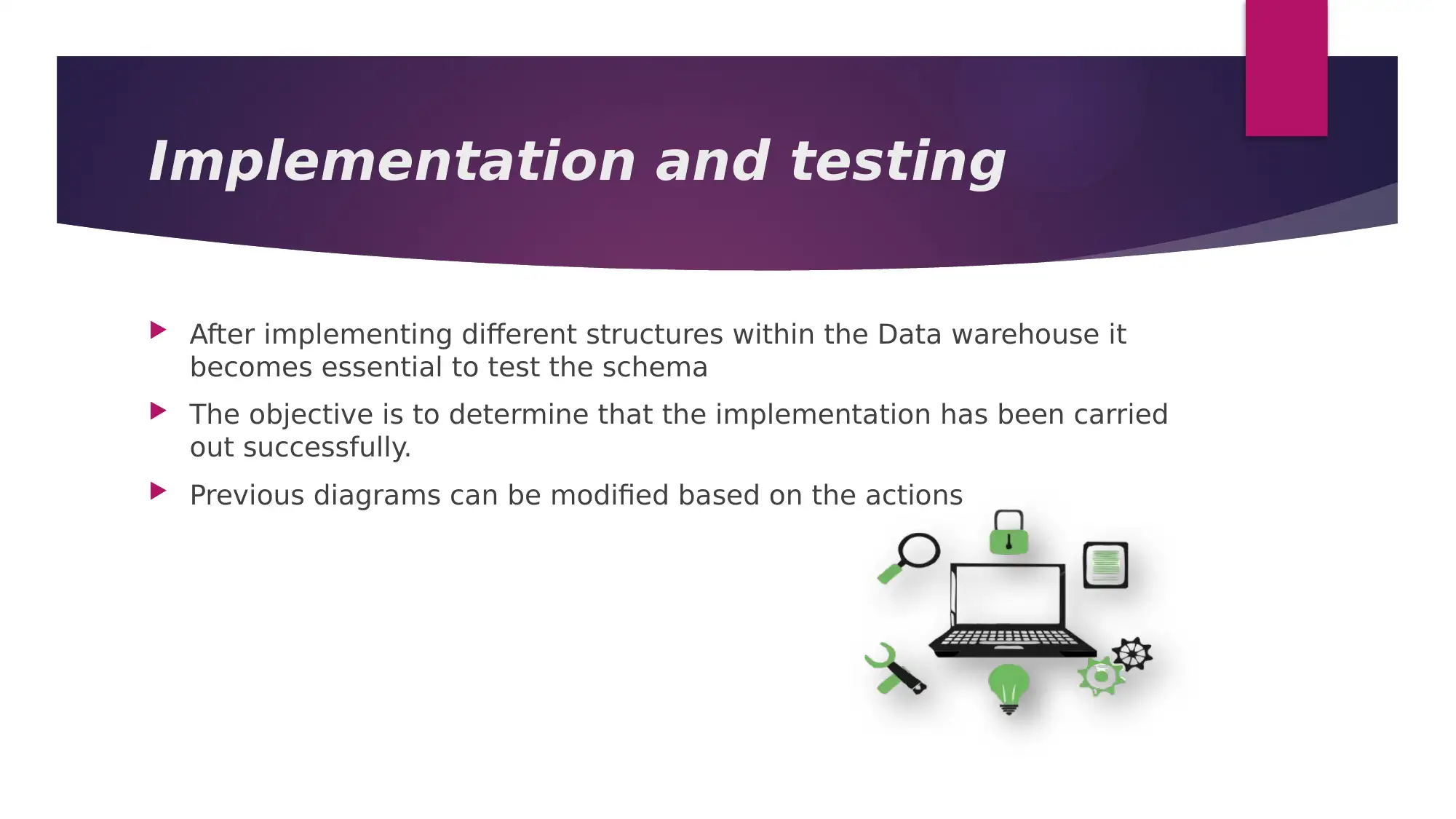
Implementation and testing
After implementing different structures within the Data warehouse it
becomes essential to test the schema
The objective is to determine that the implementation has been carried
out successfully.
Previous diagrams can be modified based on the actions
After implementing different structures within the Data warehouse it
becomes essential to test the schema
The objective is to determine that the implementation has been carried
out successfully.
Previous diagrams can be modified based on the actions
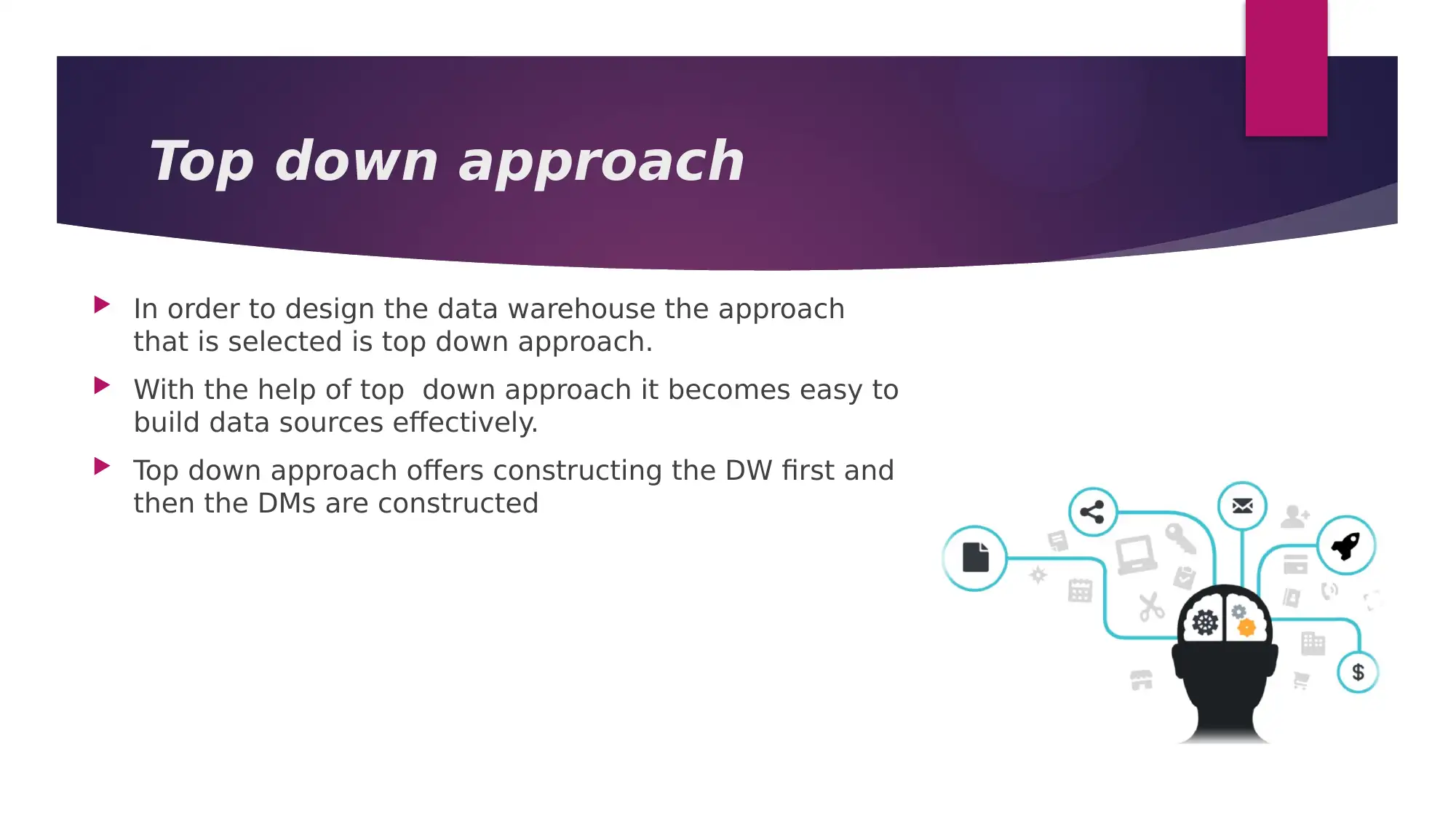
Top down approach
In order to design the data warehouse the approach
that is selected is top down approach.
With the help of top down approach it becomes easy to
build data sources effectively.
Top down approach offers constructing the DW first and
then the DMs are constructed
In order to design the data warehouse the approach
that is selected is top down approach.
With the help of top down approach it becomes easy to
build data sources effectively.
Top down approach offers constructing the DW first and
then the DMs are constructed
Secure Best Marks with AI Grader
Need help grading? Try our AI Grader for instant feedback on your assignments.
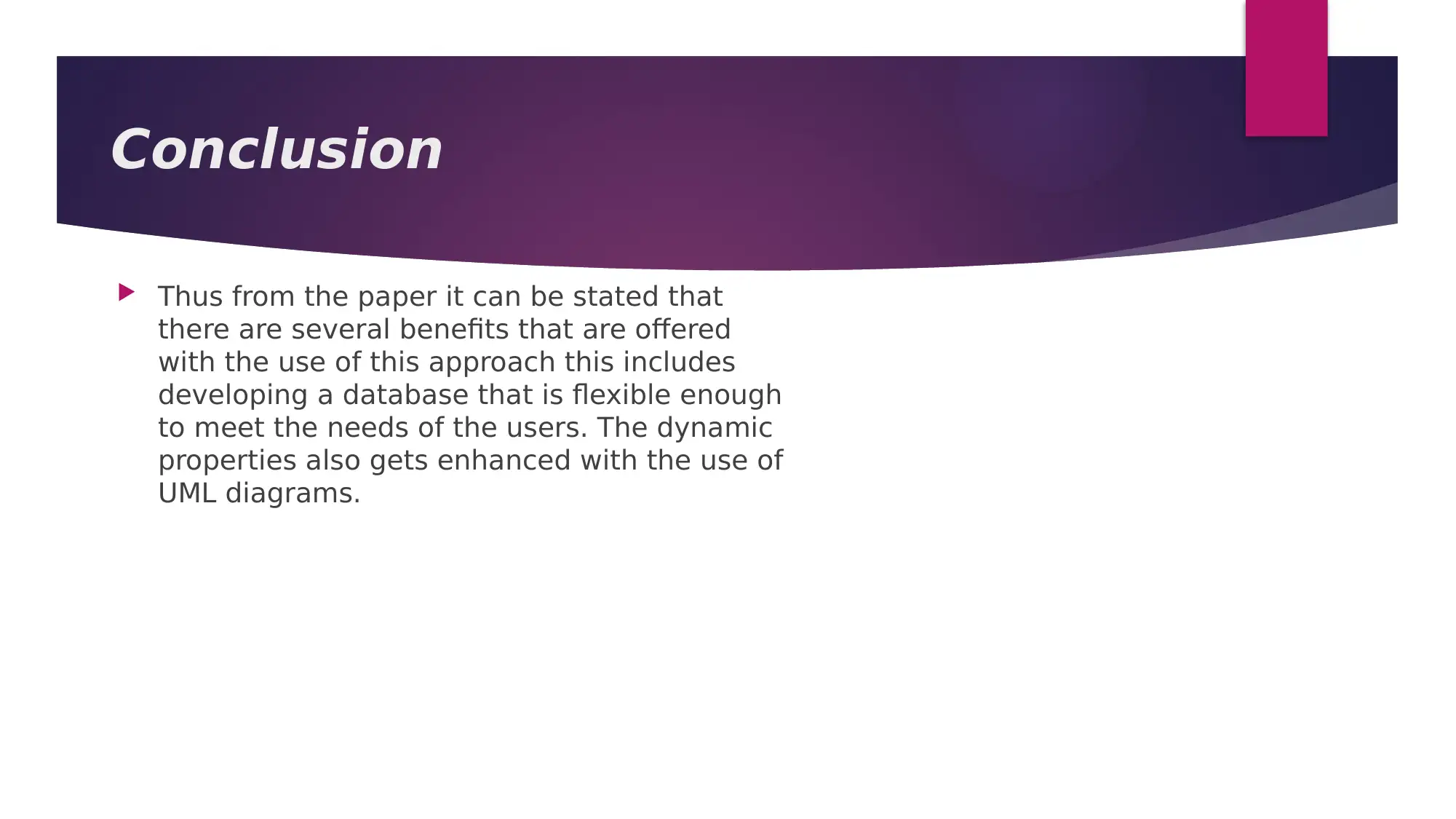
Conclusion
Thus from the paper it can be stated that
there are several benefits that are offered
with the use of this approach this includes
developing a database that is flexible enough
to meet the needs of the users. The dynamic
properties also gets enhanced with the use of
UML diagrams.
Thus from the paper it can be stated that
there are several benefits that are offered
with the use of this approach this includes
developing a database that is flexible enough
to meet the needs of the users. The dynamic
properties also gets enhanced with the use of
UML diagrams.

References
[1] F. Almeida, 2019. [Online]. Available:
https://www.researchgate.net/publication/319852408_Concepts_and_Fu
ndaments_of_Data_Warehousing_and_OLAP. [Accessed: 21- Sep- 2019].
[2]S. an-Mora and Trujillo, 2019. [Online]. Available:
https://www.researchgate.net/publication/221581537_A_Data_Warehous
e_Engineering_Process. [Accessed: 21- Sep- 2019].
[1] F. Almeida, 2019. [Online]. Available:
https://www.researchgate.net/publication/319852408_Concepts_and_Fu
ndaments_of_Data_Warehousing_and_OLAP. [Accessed: 21- Sep- 2019].
[2]S. an-Mora and Trujillo, 2019. [Online]. Available:
https://www.researchgate.net/publication/221581537_A_Data_Warehous
e_Engineering_Process. [Accessed: 21- Sep- 2019].

Thank You
1 out of 13
Related Documents
Your All-in-One AI-Powered Toolkit for Academic Success.
+13062052269
info@desklib.com
Available 24*7 on WhatsApp / Email
![[object Object]](/_next/static/media/star-bottom.7253800d.svg)
Unlock your academic potential
© 2024 | Zucol Services PVT LTD | All rights reserved.





